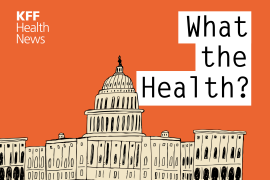Research Roundup: ACOs’ Gains And Disappointments; Hospital Readmissions
Each week, KHN compiles a selection of recently released health policy studies and briefs.
Health Affairs:
ACOs Serving High Proportions Of Racial And Ethnic Minorities Lag In Quality Performance
We analyzed racial and ethnic disparities in health care outcomes among [accountable care organizations] to investigate the association between the share of an ACO’s patients who are members of racial or ethnic minority groups and the ACO’s performance on quality measures. Using data from Medicare and a national survey of ACOs, we found that having a higher proportion of minority patients was associated with worse scores on twenty-five of thirty-three Medicare quality performance measures, two disease composite measures, and an overall quality composite measure. However, ACOs serving a high share of minority patients were similar to other ACOs in most observable characteristics and capabilities, including provider composition, services, and clinical capabilities. (Lewis et al., 1/9)
Health Affairs:
ACO-Affiliated Hospitals Reduced Rehospitalizations From Skilled Nursing Facilities Faster Than Other Hospitals
We examined whether ACO-affiliated hospitals were more effective than other hospitals in reducing rehospitalizations from skilled nursing facilities. We found a general reduction in rehospitalizations from 2007 to 2013, which suggests that all hospitals made efforts to reduce rehospitalizations. The ACO-affiliated hospitals, however, were able to reduce rehospitalizations more quickly than other hospitals. The reductions suggest that ACO-affiliated hospitals are either discharging to the nursing facilities more effectively compared to other hospitals or targeting at-risk patients better, or enhancing information sharing and communication between hospitals and skilled nursing facilities. (Winblad et al., 1/9)
Annals of Internal Medicine:
Readmission Rates After Passage Of The Hospital Readmissions Reduction Program: A Pre–Post Analysis
[Researchers sought to] evaluate whether passage of the [Medicare Hospital Readmissions Reduction Program] HRRP was followed by acceleration in improvement in 30-day RSRRs after hospitalizations for acute myocardial infarction (AMI), congestive heart failure (CHF), or pneumonia and whether the lowest-performing hospitals had faster acceleration in improvement after passage of the law than hospitals that were already performing well. ... After passage of the HRRP, 30-day RSRRs for myocardial infarction, heart failure, and pneumonia decreased more rapidly than before the law's passage. Improvement was most marked for hospitals with the lowest prelaw performance. (Wasfy et al., 12/27)
Health Affairs:
Most Newly Insured People In 2014 Were Long-Term Uninsured
In 2014—after the implementation of most of the Affordable Care Act provisions, including Medicaid expansions in some states and subsidies to purchase Marketplace coverage in all states—adults who had been uninsured for more than three years represented a larger share of the newly insured, compared to adults who had been insured for shorter periods of time. (Decker and Lipton, 1/9)
Georgetown University Center for Children and Families/The Kaiser Family Foundation:
Medicaid And CHIP Eligibility, Enrollment, Renewal, And Cost Sharing Policies As Of January 2017: Findings From A 50-State Survey
This 15th annual 50-state survey provides data on Medicaid and Children’s Health Insurance Program (CHIP) eligibility, enrollment, renewal and cost sharing policies as of January 2017, and identifies changes in these policies in the past year. ... Medicaid and CHIP are the central sources of coverage for low-income children and pregnant women, with 49 states covering children and 34 states covering pregnant women with incomes at or above 200% FPL as of January 2017 .... During 2016, states continued to upgrade and streamline Medicaid eligibility and enrollment systems and processes under the ACA, using federal funding available to support system development. ... Use of premiums and cost sharing in Medicaid and CHIP varies across states and groups. (Brooks et al, 1/12)
Urban Institute/Robert Wood Johnson Foundation:
High Premiums In Nongroup Insurance Markets
The authors note that premiums are not high in all areas, and that many areas with large recent premium increases reflect needed corrections to very low premiums in the early years of reform. However, in sources with high premium levels, the causes differ, as should appropriate solutions. The first potential problem is that sicker people are more likely to enroll in marketplace plans. The second, premiums tend to be higher if an insurer or provider group has a monopoly in their area .... Third, inadequate risk adjustment, i.e., moving premium dollars from insurers with low-cost enrollees to insurers with high-cost enrollees, may also be a factor leading to high premiums in some areas. (Blumberg and Holahan, 1/1)
Brookings/Urban Institute:
Building A Better “Cadillac”
The excise tax on high-cost health insurance plans, a provision of the Affordable Care Act (ACA), has the potential to achieve two important goals by curbing the open-ended
exclusion of employer-financed health insurance from personal income and payroll taxes. It will reduce the incentive to offer health insurance with features that permit or encourage excessive health care spending. It will also generate revenues that offset the costs of health insurance expansion. ... Now, with the election of a president who has pledged to repeal all or most elements of the ACA, even delayed implementation of the tax is in doubt. We believe that a modified version of the Cadillac tax can still play a valuable role both in fostering health care cost containment and in providing revenues to expand coverage, either under a modified version of the ACA or in an alternative that achieves a similar level of coverage. (Aaron et al., 1/4)
The Kaiser Family Foundation:
Interactive Maps: Estimates Of Enrollment In ACA Marketplaces And Medicaid Expansion
As the 115th U.S. Congress deliberates the future of the Affordable Care Act, an interactive map from the Kaiser Family Foundation provides estimates of the number of people in each congressional district who enrolled in a 2016 ACA marketplace health plan and the political party of each district’s representative as of January. (1/10)






